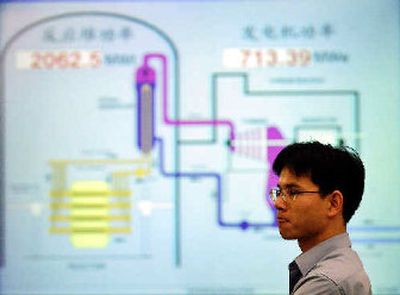China chases nuclear power

QINSHAN, China – The shadows of Chernobyl and Three Mile Island no longer reach to the pine-crested hillsides of Hangzhou Bay, where China is rushing to expand a nuclear power station to meet soaring demand for electricity for its economic boom.
Driven by crushing fuel shortages, smog and ambitions to profit from its hard-won nuclear prowess, Beijing has embarked on a quest to more than double its nuclear power generating capacity by 2020.
The push for more nuclear power means opportunities for U.S., French and Russian technology suppliers that are competing for up to $8 billion in contracts for two new nuclear power plants – the biggest deals in years for the industry.
The French nuclear group AREVA, Russia’s AtomStroyExport and Westinghouse Electric Co. – the U.S. unit of British Nuclear Fuels PLC, which Japan’s Mitsubishi Heavy Industries has offered to buy – are awaiting a Chinese decision on bids for facilities at Sanmen, in the eastern province of Zhejiang, and Yangjiang in Guangdong province, which borders Hong Kong.
“We are fully committed to transferring our advanced nuclear technology to China,” Paul Felten, a senior vice president of AREVA’s Framatome unit, said at a recent conference in Shanghai.
At Qinshan, a two-hour drive southwest from Shanghai and its 20 million residents, sites are being prepared for four new reactors, in addition to the five already operating at three different facilities.
“The excavation is almost finished,” said Yang Lanhe, general manager for Qinshan Phase II, China’s showcase for domestically developed nuclear technology and equipment. He pointed out the window to a site cleared and waiting for construction to begin.
Yang and other executives at Qinshan speak of nuclear power with the conviction of true believers.
They point to China’s own accident-free record after 14 years of nuclear power generation. And they say technology has advanced far beyond that used decades earlier, when the 1979 partial meltdown at the Three Mile Island nuclear plant in Pennsylvania and the 1986 explosion at the Chernobyl plant in the Ukraine decimated public support for atomic energy in the West.
“We know and understand that nuclear power is a clean and good energy, and we think it would be good to increase its share (of China’s total power production),” said Hu Haiyun, Communist Party boss for the Qinshan Nuclear Base.
China’s nuclear program, dating back to the 1950s, began commercial operations only in 1991, at Qinshan.
For six years, beginning in 1997, dozens of potential projects were put on hold amid concerns over excess capacity, safety and the relatively high costs of nuclear-generated electricity.
The race to build more plants resumed last year, as China struggled with blackouts amid its worst energy crisis in decades.
From the highest levels of Chinese government to the technicians running Qinshan and other plants, there is a newfound conviction that nuclear power is the most practical option for reducing the country’s reliance on heavily polluting coal-fired power plants.
China expects the share of its power supplied by nuclear generation to grow to 4 percent by 2020 from 2.3 percent today. To meet that goal, it must build about two new facilities every year.